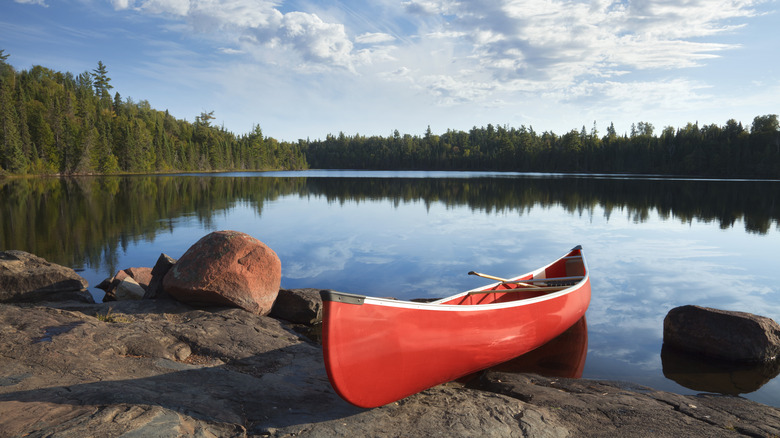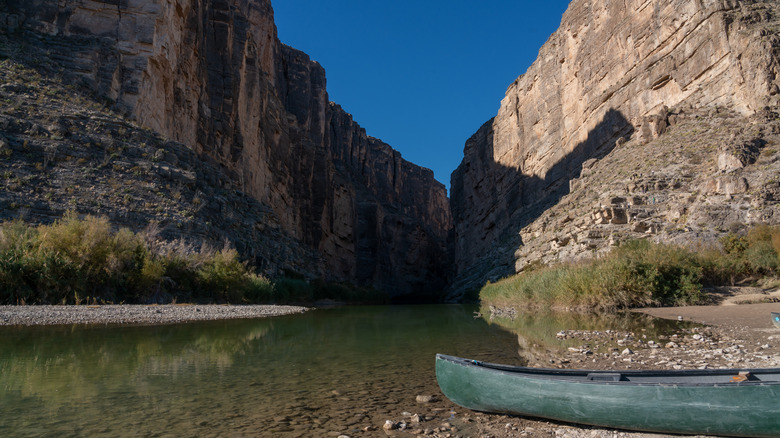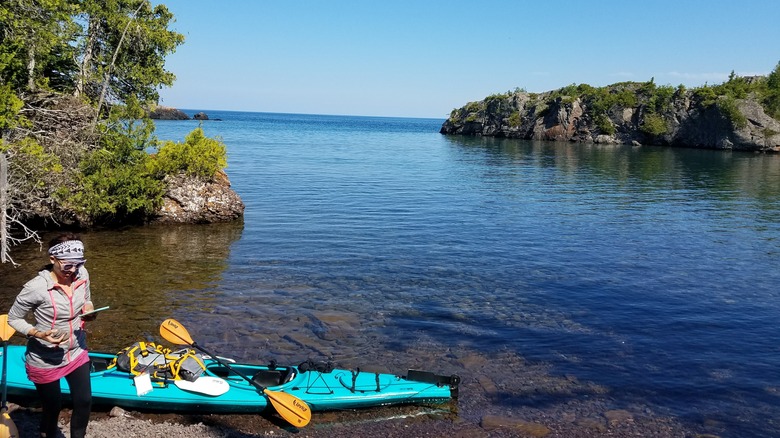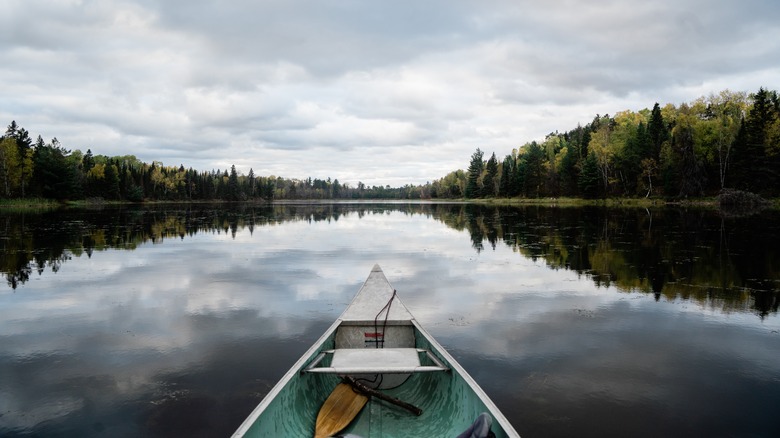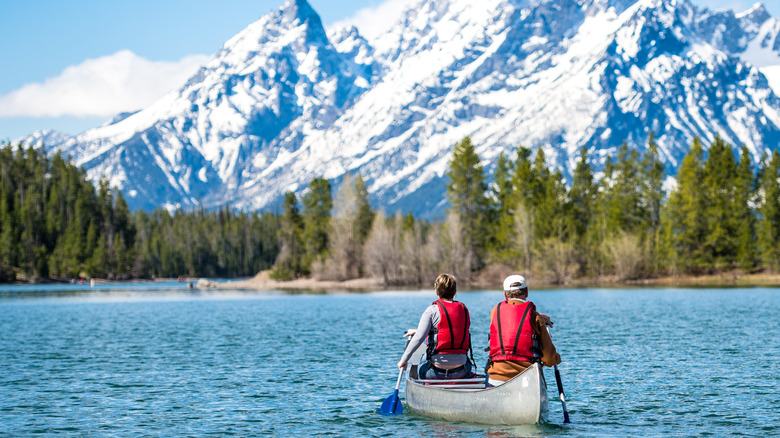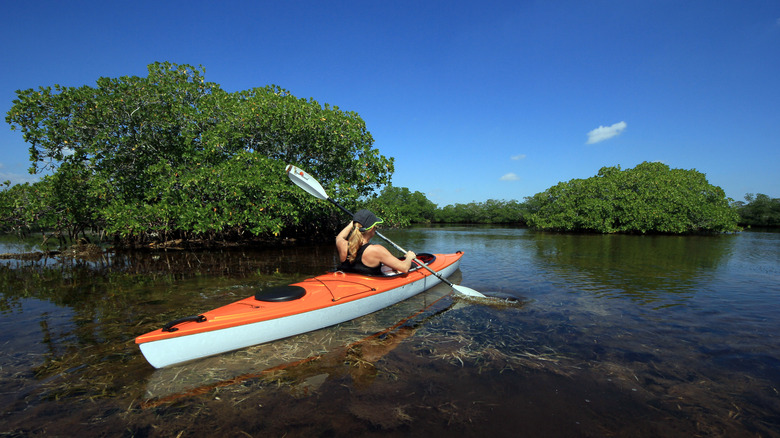Best National Parks For Canoeing, Kayaking, And Paddleboarding
According to Paddling Magazine, the paddlesports (canoeing, kayaking, and paddleboarding) industry has been experiencing unprecedented growth since the pandemic. That surge is predicted to continue throughout the 2020s. While paddling has become increasingly popular worldwide, North America is responsible for more than 50% of the paddle craft market, meaning there is a large number of both new and seasoned paddlers in the United States, Canada, and Mexico.
If you're new to paddling, you will undoubtedly spend much of your time picking up simple rules for your next canoeing or paddleboarding adventure. Additionally, you will try to avoid some of the big mistakes people make when kayaking. However, perhaps most critically, you will be looking for paddling destinations. Both experienced and novice paddlers may be surprised to learn there is plenty of public access in national parks, which are also highly rated paddling sites. The list of NPS properties with paddling access includes parks in every state, as well as the freshwater and marine national parks that you have to explore this summer. So, if you're seeking unique and picturesque places to paddle, arm yourself with an entrance pass and visit some of these parks.
Rio Grande River, Big Bend National Park, Texas
Located in the far western corner of Texas, Big Bend National Park is situated on the banks of the Rio Grande River, which forms the southern border between the United States and Mexico. Due to its remote location, rugged terrain, extreme temperatures, and the creatures to beware of in Big Bend, it is considered one of the most dangerous national parks in the United States. However, these same elements combine to give paddlers a scenic and unique experience when paddling the iconic Rio Grande River as it winds through sheer canyon walls, desert, and towering mountains. The novelty of paddling along an international border only adds to the allure. While crossing over this international boundary is allowed (without a passport), landing on the Mexican side of the river is strictly forbidden.
There is a wide array of possible trips on the Rio Grande River within Big Bend National Park, ranging from half-day paddles appropriate for novices to overnight trips that require the skill of a seasoned paddler. Additionally, paddlers have the option of DIYing trips or booking outfitters or guides. Regardless of what type of trip you desire, it is recommended to check the park's paddling FAQ sheet before planning your excursion.
Lake Superior, Isle Royale National Park, Michigan
Situated in the northwest portion of Lake Superior just inside the U.S.-slash-Canada border, Isle Royale National Park is literally surrounded by paddling opportunities. However, before planning a paddle, there are a couple of steps that must be taken first. Step one is figuring out how to get to the park, which is not connected to land. Essentially, there are three ways to reach Isle Royale National Park: via ferry, seaplane, or private boat. There are two ferries and one seaplane departure point in Michigan and two more in Minnesota (a ferry and seaplane). Kayaks and canoes can be transported on ferry boats. Rentals are also available on the island. The departure point and transportation manner you choose will dictate which end of the island you will arrive at.
Once the transportation question has been answered, it is recommended that the park's paddler orientation video be reviewed. Next, decide the type of paddling you wish to do. Keep in mind that open-water paddling on Lake Superior requires a high level of skill, so novice and intermediate-level paddlers are better off sticking to the bays and interior lakes. The park affords the choice of the open waters of Lake Superior, as well as smaller bays and interior lakes. Finally, secure any necessary permits for the trip you plan.
Boundary waters, Voyageurs National Park, Minnesota
Tucked snug against the U.S.-slash-Canada border, the 200,000-plus acre Voyageurs National Park encompasses countless lakes and ponds, as well as vast stretches of streams and wetlands. Nearly half the park is comprised of water. This gives paddlers an almost endless amount of options for routes and trips. The portion of the park that is not covered in water is sprinkled with volcanic bedrock and dense forest, affording amazing panoramic views for paddlers.
In addition to day-trip paddle excursions, backcountry paddling and camping trips are very popular in Voyageurs National Park. Those overnighting along the boundary waters will be treated to amazing night sky views and also have an opportunity to experience and photograph the Northern Lights. See our best tips for getting the perfect picture of the Northern Lights.
Paddlers have the option of taking their own canoe or kayak to Voyageurs National Park or renting a craft from one of several private outfitters approved to provide rentals. Note that canoes are stationed at backcountry campsites. Be sure to check park regulations and secure any campsite reservations and necessary permits before heading out on a boundary water adventure in Voyageurs National Park.
Snake River, Grand Teton National Park, Wyoming
Paddlers in Grand Teton National Park are afforded amazing views of towering peaks, thanks to the namesake mountain range of the park. Whether on the Snake River or one of a handful of high mountain lakes within the park, paddlers are treated to spectacular landscapes. When planning your Grand Teton paddling adventure, keep in mind that some stretches of the Snake River require a fairly high degree of skill. So, while DIY trips are certainly possible, if you are not a very experienced paddler, you may want to consider going with a guide or outfitter, particularly if you want to see some of the more challenging portions of the river.
Those looking for calmer waters have nearly a dozen mountain lakes from which to choose. All but two of these lakes are restricted to paddle-powered craft only. There are three marinas within the park as well, but they are only open during the summer. In addition to canoeing and kayaking, these lakes are also popular among paddleboarders during the summer months. Be advised that there are some restrictions and regulations regarding lake access, parking, and permits. Therefore, it is important to visit the park's information page while planning your visit.
Biscayne Bay, Biscayne National Park, Florida
Biscayne Bay National Park may be the only marine national park on this list, but it is hardly the only coastal park in the NPS that gives kayakers, canoers, and paddleboarders access to serene waters. However, in addition to being considered one of the top national parks for saltwater fishing, Biscayne Bay is also one of the most picturesque. Given that 95% of this park is water, there are plenty of options for paddlers.
The clear waters of Biscayne Bay are bounded by hundreds of miles of mangrove-lined shorelines. Additionally, there are miles of channels weaving through a maze of mangrove islands and shallow lagoons. Paddlers will encounter a myriad of bird species and can peer through the water to see a diverse array of marine life. They also have the option of beaching their crafts and snorkeling over the shallow reefs in the bay. Paddleboarding is very popular for short-day adventures, while canoes and kayaks are preferred for those carrying fishing or snorkel gear or are overnight camping.
